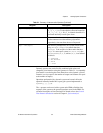Chapter 3 Building System Connections
© National Instruments Corporation 3-5 Xmath Control Design Module
• By default, feedback is defined to be negative.
• The number of outputs from the first system must equal the number of
inputs to the second system.
• The number of outputs from the second system must equal the number
of inputs in the first.
• Both systems must have the same sample rate.
• Improper dynamic systems (systems with more zeros than poles) are
not allowed.
• When only one system is specified, it must be square (it must have an
equal number of inputs and outputs).
Example 3-1 Using afeedback( ) to Connect Two Systems
Sys1 = system([.5,1;0,2],[1,0]',[0,1],0);
Sys2 = system([1,-.2;1,0],[1,0]',[1,1],0);
saf = afeedback(Sys1,Sys2);
Algorithm
If only one system input (Sys
1
) is provided to afeedback( ), the second
input (
Sys
2
) defaults to a zero-state system with unity gain. This is
analogous to a state-space system with
NULL values for the A, B, and C
matrices, and with an identity matrix for D. Notice that you use the Xmath
definition of a non-square identity matrix. In this case, the row dimension
of D equals the number of inputs to
Sys
1
, and the column dimension equals
the number of outputs of Sys
1
. In the following discussion, you denote the
state-space matrices of
Sys
1
by A
1
, B
1
, C
1
, and D
1
, and you follow the same
convention for
Sys
2
.
The two systems are first internally converted to a state-space form, if
necessary, and subdivided into the A, B, C, and D state-space matrices.
Scaling matrices S1
and S2 are computed for Sys
1
and Sys
2
as follows:
S
1
= I + D
1
D
2
S
2
= I + D
2
D
1
Additionally, you define:
B
1s
= B
1
/S
2
and D
1s
= D
1
/S
2
B
2s
= B
2
/S
1
and D
2s
= D
2
/S
1
Matrix right-division problems must be well-posed, with the scaling
matrices S
1
and S
2
nonsingular. afeedback( ) displays an error message


















